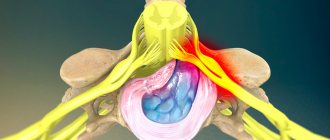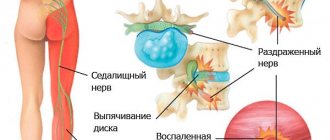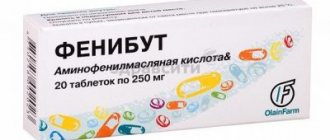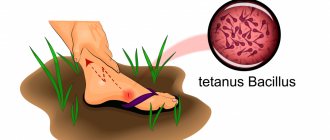The disease develops when the pathogen enters the body through damage to the skin and mucous membranes (wounds, burns, frostbite). Minor injuries sustained when working with soil on personal plots are especially dangerous.
The incubation period of the disease ranges from 3 to 30 days.
Often, at the onset of a person’s illness, the wound has healed and the sick person does not remember the location and nature of the damage. First, vague symptoms appear: deafness, headaches, loss of appetite, anxiety, a slight increase in temperature, and later a convulsive contraction of the masticatory and facial muscles joins. Then the cramps can spread to the entire muscle. When the occipital muscles and back muscles are affected, the body bends backward. The arms and legs are less affected, but extensor spasms are possible. Particularly dangerous are prolonged spasms of the respiratory muscles, which lead to death.
Emergency prevention of tetanus is carried out for any injuries and wounds with a violation of the integrity of the skin and mucous membranes, frostbite, and burns of the second, third and fourth degrees, animal bites, penetrating injuries or surgical interventions on the gastrointestinal tract, in unvaccinated persons or persons with an unknown vaccination history , out-of-hospital abortions, childbirth outside of medical institutions, gangrene or tissue necrosis of any type, abscesses, carbuncles. Emergency prophylaxis of tetanus is carried out until the 20th day from the moment of injury. The decision to carry out emergency prophylaxis is made based on the conclusion of a doctor at a clinic or hospital.
Immunization is the only reliable way
prevention of tetanus. Vaccinations against tetanus are mandatory and are carried out in accordance with the national calendar of preventive vaccinations from the age of three months, along with vaccinations against diphtheria. Vaccination consists of 3 vaccinations followed by revaccination at the age of 18 months, 7 years, 14 years, and then revaccination is carried out every 10 years until the last revaccination (for life).
Vaccinations against tetanus are carried out in medical institutions (clinics) at the place of residence or work free of charge.
At the same time, against the background of mass immunization in the Russian Federation, the epidemiological features of tetanus have changed: diseases are registered among the adult population, mainly among people over 50 years of age, who account for about 70%; the most affected group are pensioners. Infection occurs in 90% of cases with minor injuries, for which the victims, as a rule, do not seek medical help. But an early visit to the surgical office or emergency department (on weekends and holidays) to a medical institution and emergency tetanus prophylaxis can save your life and the lives of your loved ones.
Tetanus
Tetanus
4332 25 January
IMPORTANT!
The information in this section cannot be used for self-diagnosis and self-treatment.
In case of pain or other exacerbation of the disease, diagnostic tests should be prescribed only by the attending physician. To make a diagnosis and properly prescribe treatment, you should contact your doctor. Tetanus: causes, symptoms, diagnosis and treatment methods.
Definition
Tetanus is a dangerous infectious disease caused by the tetanus bacillus Clostridium tetani
. This bacterium is extremely stable in the environment: its spores remain viable for years, and at a temperature of 90°C - for about two hours. Vegetative forms of clostridia die within a few minutes in boiling water and within 3-6 hours after treatment with antiseptics and disinfectants. Once in the wound, bacteria begin to produce a toxin that affects the nervous system, leading to severe muscle spasms and cramps.
As the disease progresses, muscle spasm causes severe breathing problems and can ultimately be fatal.
Tetanus can be contracted anywhere in the world, but most cases of infection occur in hot countries with poor sanitary and hygienic conditions. In countries with temperate climates, the peak incidence occurs in the summer-autumn period.
Causes of tetanus
The lack of preventive vaccination of the population plays a huge role in the spread of infection.
Tetanus bacilli live in the soil. The route of infection is contact. Bacteria enter the body through wounds, abrasions, burns, frostbite, etc.
After entering the wound, bacteria begin to produce a toxin that penetrates the processes of nerve cells, causing spastic muscle contractions and cramps.
Due to its ability to exist for a long time in the form of spores in soil, water bodies, and on objects, the tetanus causative agent can enter any premises with dust and dirt and infect any surfaces, including medical ones.
Classification of the disease
Depending on the route of infection:
- wounded,
- postoperative,
- postpartum,
- post-burn,
- after frostbite,
- post-injection,
- tetanus of newborns.
By prevalence:
- local (only the muscles closest to the wound are affected),
- generalized (all muscles of the body are affected).
According to the clinical course:
acute, chronic, with a mild course (symptoms are mild).
By severity:
mild form (about 3 weeks pass from the moment of infection to the first symptoms), moderate form (symptoms appear 2 weeks after infection), severe (symptoms appear 9–15 days after infection), extremely severe (the incubation period lasts only 3 -5 days).
Tetanus symptoms
The first symptoms appear on average 7–10 days after infection; in rare cases, the disease can develop earlier.
There are three classic symptoms of tetanus:
- Trismus, that is, convulsions and stiffness of the jaw muscles, opening the mouth is difficult, and in the later stages of the disease it becomes impossible. Contraction of the facial muscles creates a specific expression of the “sardonic grimace” - a simultaneous expression of suffering and a smile;
- stiff neck, which causes stiffness and pain in the neck muscles, limited neck mobility when the head is tilted forward;
- dysphagia (impaired swallowing function).
Other symptoms of tetanus:
- pain in the wound area and sometimes twitching of nearby muscles;
- stiffness of the abdominal muscles;
- painful body spasms that last for several minutes, usually caused by minor phenomena - a draft, loud noise, touch, light;
- headache;
- pain in the back and neck;
- increased sweating.
As the disease progresses, cramps spread to the muscles of the whole body (opisthotonus), the patient, to alleviate the condition, takes various forced positions - arches, bends to the side or freezes like a pillar (hence the name of the disease).
In severe cases, the cramps are so severe that they can lead to muscle tears and broken bones.
Severe disease is accompanied by an increase in body temperature, a decrease in blood pressure, and an increase in heart rate.
Diagnosis of tetanus
As a rule, an accurate diagnosis can be made based on the clinical picture in the presence of a wound indicating possible infection.
Laboratory diagnosis is not performed, since the presence of antibodies in the blood may indicate vaccination in childhood. With tetanus, there is no increase in antibody titers, since even lethal doses of exotoxin do not cause an immune response. The cerebrospinal fluid (CSF) also remains unchanged, despite damage to the nervous system.
In some cases, bacteriological methods are used (microscopy of fingerprint smears, histological examination of tissues excised during surgical treatment of wounds, inoculation of wound discharge on nutrient media under anaerobic conditions), which make it possible to detect the pathogen at the location of the wound. However, it is possible to isolate a culture of the pathogen from a wound in only 30% of patients.
Which doctors should I contact?
In case of injury with a violation of the integrity of the skin, frostbite or burn, you should consult a traumatologist or surgeon, who, after examination, collection of anamnesis and complaints, will refer the patient to specialized specialists: an infectious disease specialist, a neurologist.
Treatment of tetanus
Treatment of patients with tetanus is carried out only in a hospital. In severe cases of the disease, the patient is hospitalized in the intensive care unit.
Strict bed rest and complete rest, reduction of noise and light exposure are indicated.
Muscle relaxants and antipsychotics are used to relieve seizures. Due to swallowing disorders, medications are often administered intramuscularly or intravenously.
If the respiratory muscles are damaged, artificial ventilation may be required.
The administration of antitetanus serum is mandatory. Moreover, the sooner it is introduced, the greater the likelihood of neutralizing the toxin.
Surgical treatment consists of treating the wound, removing foreign bodies, prescribing antibacterial therapy if a bacterial infection is suspected and in order to prevent the development of a purulent process. The wound cannot be sutured to prevent the proliferation of tetanus bacillus, since a closed wound without access to oxygen is a beneficial environment for this bacterium.
Particular attention is paid to replenishing fluids, providing nutrition with sufficient calories, rich in vitamins and microelements. In case of severe swallowing impairment, nutrition is provided with liquid nutritional mixtures using a probe - a special thin tube that is inserted through the nose into the stomach cavity.
Complications
Complications are divided into early, which occur in the midst of the disease, and late, which can remain after recovery.
Early complications include:
- Respiratory infections (bronchitis, pneumonia) - occur as a result of impaired ventilation of the lungs associated with muscle spasms and prolonged bed rest.
- Myocardial infarction - observed in severe and extremely severe cases of tetanus, since the heart muscle, like other muscles of the body, can be exposed to tetanus toxin. The toxin is especially dangerous for older people and patients with cardiovascular diseases.
- Sepsis is a systemic inflammatory response in response to microorganisms entering the bloodstream. The danger of sepsis is that the inflammatory process affects all organs and systems of the body, disrupting their proper functioning, and in some cases can lead to death. Treatment of sepsis requires the simultaneous administration of several intravenous antibiotics, constant monitoring of laboratory blood parameters, pulse, blood pressure, body temperature, and urination.
- Bone fractures, dislocations, and muscle ruptures are characteristic of extremely severe tetanus.
Late complications:
- Spinal deformity.
- Contractures of muscles and joints are a condition in which a muscle or joint retains restriction and stiffness in movement even after recovery from the underlying disease.
- Heart rhythm disturbances.
- Temporary paralysis of the cranial nerves, the most common manifestation of which is impaired swallowing function, double vision, ptosis (drooping) of the eyelid.
Prevention of tetanus
There are planned and emergency prevention.
Planned prevention includes vaccination, which is carried out from the birth of the child.
In Russia, the course of vaccination against tetanus consists of 3 DTP vaccinations (at the age of 3, 4.5 and 6 months) and a single revaccination at the age of 18 months. Further revaccination is carried out at 6–7 years and at 14 years with the ADS-M toxoid vaccine. Subsequent revaccinations are carried out every 10 years.
All vaccinations must be included in vaccination certificates. A full course of vaccinations provides protection for 95–100% of the vaccinated population.
Emergency prevention should be carried out in unvaccinated or incorrectly vaccinated people who receive any mechanical damage to the skin. To do this, anti-tetanus serum is administered as early as possible (permissible up to 20 days from the moment of injury). Before its administration, a test with diluted serum is carried out: if the diameter of the redness is less than 1 cm, the test is negative, if 1 cm or more, it is positive. If the test is negative, the serum is injected subcutaneously into the outer surface of the shoulder or subscapular area. If the test is positive, serum administration is contraindicated. In this case, human immunoglobulin is administered.
Sources:
- Infectious diseases: national guidelines / Ed. N.D. Yushchuka, Yu.Ya. Vengerova. - M.: GEOTAR-Media, 2009. P. 521–529.
- Ryumin A.M., Sobolevskaya O.L., Korochkina O.V., Volsky N.E., Mikhailova E.A., Otmakhova I.A., Sobchak D.M., Khryaeva O.L. A case of mild tetanus: tactical features of management // Nizhny Novgorod State Medical Academy. 2021. pp. 98–100.
IMPORTANT!
The information in this section cannot be used for self-diagnosis and self-treatment. In case of pain or other exacerbation of the disease, diagnostic tests should be prescribed only by the attending physician. To make a diagnosis and properly prescribe treatment, you should contact your doctor.
Scheme for selecting prophylactic agents for emergency specific prevention of tetanus.
Notes: 1. – Instead of 0.5 ml of AC toxoid, you can use ADS-M toxoid if vaccination against diphtheria with this drug is necessary. If the localization of the wound allows, AS, toxoid is preferably injected into the area of its location by subcutaneous injection 2. – Use one of the indicated drugs: IPSC or PSS (it is preferable to administer IPSC) 3. – For infected wounds, 0.5 ml of AS toxoid is administered, if 5 or more years have passed since the last revaccination. 4. – The full course of immunization with AS toxoid consists of two vaccinations of 0.5 ml each with an interval of 30-40 days, revaccination after 6-12 months. Same dose. According to the abbreviated scheme, the full course of immunization includes a single vaccination with AC toxoid in a double dose (1 ml) and revaccination after 6 months. – 2 years with a dose of 0.5 ml of AS-anatoxin. 5. – Two vaccinations according to the regular immunization schedule (for adults and children) or one vaccination according to the abbreviated immunization schedule for adults. 6. – In case of “infected” wounds, IPS or PSS is administered 7. – All persons who received active-passive prophylaxis, to complete the course of immunization after 6 months – 2 years, must be revaccinated with 0.5 ml of AS-toxoid 8. – If necessary, prescribe AS-toxoid for children under 6 years of age, the drug should be administered intramuscularly. 9. – After normalization of the post-traumatic state, children should be vaccinated with the DTP vaccine.
| Previous vaccinations against tetanus with a drug containing tetanus toxoid | Age group | Time elapsed since the last vaccination | Tetanus toxoid | Tetanus immunoglobulin (human) | Antitetanus serum (horse) |
| 1 | 2 | 3 | 4 | 5 | 6 |
| Full course of routine vaccinations according to age | Children and teenagers | Regardless of the deadline | Do not enter | Do not enter | Do not enter |
| A course of routine vaccinations without the last age-related revaccination | Children and teenagers | Regardless of the deadline | 0.5 ml | Do not enter | Do not enter |
| Full course of immunization “4” | Adults | No more than 5 years | Do not enter | Do not enter | Do not enter |
| More than 5 years | 0.5 ml | Do not enter | Do not enter | ||
| Two vaccinations "5" | All ages | No more than 5 years | 0.5 ml | Do not enter | Do not enter |
| More than 5 years | 0.5 ml | Do not enter | Do not enter | ||
| One vaccination | All ages | No more than 2 years | 0.5 ml | Do not enter "6" | Do not enter "6" |
| More than 2 years | 1.0 ml | 250 IU | 3000 IU | ||
| Not vaccinated | Children under 5 months. | — | Don't enter "9" | 250 IU | 3000 IU |
| Other ages | — | 0.5 ml "7.8" | 250 IU | 3000 IU | |
| No documentation of vaccinations | |||||
| There was no history of contraindications to vaccinations | Children under 5 months. | — | Do not enter | 250 IU | — |
| Children from 5 months, teenagers, military personnel | — | 0.5 ml | Do not enter "6" | Do not enter "6" | |
| There was no history of contraindications to vaccinations | Former military personnel | — | 0.5 ml | Do not enter "6" | Do not enter "6" |
| Other contingents | All ages | — | 1.0 ml | 250 IU | 3000 IU |
Tetanus symptoms
The first symptoms of tetanus appear several days or weeks after contracting tetanus. The average incubation period is seven to eight days. Typically, tetanus bacteria enter the body through a break in the skin.
The most common symptoms of tetanus are the following (in order of appearance):
- Cramps and tension in the jaw muscles
- Neck muscle tension
- Difficulty swallowing
- Abdominal muscle tension
Painful generalized (affecting all muscles of the body) tonic convulsions, which are provoked by a loud sound, bright light, touching the patient, etc. Such convulsions are called opisthotonus.
In addition to these main symptoms, general infectious symptoms of tetanus may occur:
- Fever;
- Increased sweating;
- High blood pressure;
- Heartbeat.
Treatment of tetanus
Therapy is carried out only in a medical hospital, regardless of the form and severity of tetanus. In severe cases, treatment is carried out in an intensive care unit. Therapeutic measures for tetanus are complex and include:
- Introduction into the body of a specific immune antidote that inactivates tetanospasmin and other exotoxins of the tetanus bacterium - for this, horse immune serum or human anti-tetanus immunoglobulin is used. These biological products contain antibodies that bind and neutralize toxins in the patient's body.
- The use of muscle relaxants (myorelaxonium, ditilen), they relieve an attack of titanic convulsions for a period of 15-20 minutes.
- Intravenous administration of special buffer solutions to reduce the severity of metabolic acidosis (sodium bicarbonate solution). To prevent respiratory arrest, tracheal intubation is performed and the patient is transferred to artificial pulmonary ventilation (ALV).
- Centrally acting sedatives (phenobarbital, seduxen), which help reduce the severity of impulses in motor neurocytes of the central nervous system.
- The use of cardiac glycosides to normalize pumping function and heart rhythm.
- Antibiotics to prevent the development of secondary bacterial infections.
The patient is discharged from the hospital only after complete normalization of his general condition and the absence of re-development of cramps and tension of the striated muscles.
Publications in the media
Tetanus is an acute, severe infectious disease that occurs with intermittent tonic and clonic convulsions of skeletal muscles, leading to asphyxia.
Etiology. The causative agent is the mobile anaerobic spore-forming bacillus Clostridium tetani. Vegetative forms of the pathogen produce an exotoxin that does not exhibit immunogenic properties and affects the central nervous system. Spores can persist in the soil for a long time.
Risk factors • Burns • Infection of the hearing organs (with perforation of the eardrum) • Infection of the uterus in the early postpartum period • Getting into an open wound with contaminated soil • Frostbite • Infection of umbilical wounds in newborns • Skin ulcers • Surgical wounds • Crushed and lacerated wounds.
Incidence: 0.03 per 100,000 population in 2001.
Epidemiology. The natural reservoir and source of infection is soil; The pathogen is also part of the microflora of the colon of farm and wild animals. The entry point for infection is household and industrial wounds, often of mild severity, when the patient does not seek medical help. An increased incidence is noted in regions with a warm climate, which creates conditions not only for the long-term preservation of spores in the soil, but also for their germination. The incidence increases significantly during military operations in the wounded; The main risk group in peacetime is agricultural workers (80–86% of cases).
Pathogenesis. A necessary condition for the development of the disease is the lack of oxygen access and the presence of necrotic tissue in the wound, which is usually the case with lacerated, crushed wounds, as well as after the application of surgical sutures. In such situations, the spore germinates into a vegetative form that produces tetanus toxins - tetanospasmin and tetanolysin (tetanohemolysin). Tetanospasmin acts remotely, because bacteria rarely leave the wound. Initially, the toxin acts on peripheral nerves, causing local tetanic muscle contractions. The toxin is fixed on the surface of the nerve cell (possibly on a specific receptor), penetrates it (due to ligand-mediated endocytosis) and enters the cells of the central nervous system through retrograde axonal transport. The mechanism of action is associated with the suppression of the release of inhibitory neurotransmitters, in particular glycine and g-aminobutyric acid in central and peripheral synapses, as well as with the effect on synaptobrevin and cellubrevin. Tetanolysin has a hemolytic, cardiotoxic effect and plays a less important role in the pathogenesis of the disease. With tetanus, interneurons of polysynaptic reflex arcs are affected, which removes all types of inhibition. Excitation impulses continuously flow to the muscles, causing their tonic tension. Tetanic convulsions occur periodically. At the same time, damage to vital parts of the brain is observed, especially the respiratory and cardiovascular centers and the nuclei of the vagus nerve.
Clinical picture
• The duration of the incubation period is 5–14 days. A short incubation period indicates a poor prognosis. Depending on the characteristics of the organism and the place of penetration of the pathogen, 4 forms of the disease are distinguished: generalized, local, encephalitic (Brunner's tetanus) and neonatal. In the dynamics of the disease, the patient’s consciousness remains clear all the time.
• Generalized form. It starts off sharp. Three leading symptoms are characteristic: trismus (difficulty opening the mouth due to convulsive contraction of the masticatory muscles), risus sardonicus (sardonic smile - a peculiar expression of suffering and a smile at the same time, caused by spasm of the facial muscles) and dysphagia. As a result of spasms of the facial muscles, a wrinkled forehead and narrowed palpebral fissures are also observed. Spasm of the pharyngeal muscles, pain and painful stiffness of the muscles of the back of the head make swallowing difficult. Gradually, tonic tension covers all large muscles from top to bottom: the muscles of the back, abdomen and limbs. Patients lie in bed in a characteristic position - the head is thrown back, the lumbar part of the body is raised above the bed, an arm can be freely placed between the back and the bed (opisthotonus), legs are extended, their movements are limited. The muscles of the feet and hands are not tense. Tonic tension sharply limits the excursion of the chest, which leads to increased breathing. Constant muscle tension causes severe muscle pain and leads to the accumulation of lactic acid in the muscles, acidosis. Against the background of muscle hypertonicity, sharply painful tetanic spasms occur, quickly spreading to a large group of muscles. The duration of the convulsive syndrome can vary: from a few seconds to a minute or more. Patients cry out from unbearable pain, bite their tongues, tachycardia and severe sweating appear. During this period, death from asphyxia may occur due to spasm of the diaphragm, larynx and intercostal muscles. As a result of difficult lung excursion, the main and often fatal complication is secondary pneumonia.
• Particularly severe forms include encephalitic tetanus (Brunner's tetanus) with damage to the upper parts of the spinal and medulla oblongata (respiratory center, vagus nerve nuclei, cardiovascular center), gynecological tetanus and neonatal tetanus.
• In rare cases, localized tetanus with periodic spasms in the affected area is observed. More often this form is a prodrome of generalized forms. It manifests itself as muscle damage in the wound area, where pain appears, and then tonic tension and muscle cramps occur around the injury.
Research method - isolation of the pathogen • The pathogen is usually detected at the site of entry into the patient's body. Therefore, it is most rational to study various material taken from the wound site. In cases where the entrance gate is unknown, the patient should be carefully examined to identify abrasions, scratches, catarrhal and inflammatory processes, attention should be paid to old scars after injuries, because the pathogen can persist in them for a long time • In some cases, mucus from the nose, bronchi, pharynx, plaque from the tonsils, as well as discharge from the vagina and uterus (with postpartum tetanus or abortion) are examined. When bacteriological examination of corpses, the possibility of generalization of the infection is taken into account and blood and pieces of the liver and spleen are taken for analysis • The material is inoculated on conventional bacteriological media under anaerobic conditions. The material to be studied is from a patient or corpse, dressing and suture surgical material, as well as soil, dust and air. • When examining material from a patient or corpse, a biological test is carried out on mice in parallel with the bacteriological analysis.
Differential diagnosis • Oral abscesses • Subarachnoid hemorrhages • Epileptic seizures • Meningoencephalitis • Peritonsillar abscesses • Neuroleptic syndrome • Hypocalcemic convulsions • Strychnine poisoning • Withdrawal syndrome.
Treatment • Diet as tolerated. With severe trismus - feeding through a nasogastric tube • Surgical treatment of wounds, incl. healed at the time of illness, with excision of necrotic tissue and provision of air access. It is recommended to inject 3000–10000 IU of antitetanus serum into the wound area. • It is necessary to place the patient in an isolated dark room and limit his exposure to external irritants (noise, draft, etc.) as much as possible. In case of severe trismus, the patient is fed through a tube inserted into the nasal passage • To neutralize the incoming toxin, tetanus adsorbed antitoxin 1,500–2000 IU/kg is administered. In case of severe cases, 100,000 IU of serum is administered intramuscularly and up to 50,000 IU intravenously, diluted in 0.9% sodium chloride solution in a ratio of 1:5–1:10 and heated to 37 °C. Typically, the antitoxin is administered twice with an interval of 3-5 days • Tetanus g-globulin: for prevention - 3 ml (at least 450 IU) intramuscularly, for treatment - 3000-10,000 IU once. It is possible to administer antitetanus serum up to 100,000-150,000 IU • Benzylpenicillin 2 million units IV every 6 hours, if penicillin is intolerant - metronidazole 30 mg/kg. Duration of therapy from 10 to 14 days • To relieve convulsive syndrome - antipsychotics in combination with narcotic analgesics and antihistamines; when blood pressure drops below 70 mm Hg. the administration of drugs is stopped and muscle relaxants (curare-like drugs) are prescribed with the obligatory transfer of the patient to mechanical ventilation • Patients must undergo regular catheterization of the bladder.
Complications • Compression fracture of the vertebral bodies (Lehndorff–Graciansky fracture) • Muscle ruptures and contractures • Damage to the III, IV, VII cranial nerves • Bronchopneumonia • Lobar pneumonia • Sepsis • Rhabdomyolysis • Intestinal paresis.
Course and prognosis. The annual mortality rate from tetanus exceeds 100,000 people (in Russia - 5–6 per 10 million). Mortality is higher in youth and old age. The disease is fatal in 25–50% of cases.
Prevention • Active immunization is carried out in childhood. Revaccinations are recommended every 10 years. Preparations: adsorbed diphtheria-tetanus-pertussis vaccine (DPT), adsorbed diphtheria-tetanus toxoid (ADS), adsorbed diphtheria-tetanus toxoid with reduced Ag concentration (ADS-M), adsorbed tetanus toxoid (AS) • Selection of drugs •• DTP is used -vaccine, ADS- or ADS-M toxoid •• Revaccination of adults previously fully immunized with DPT, ADS, ADS-M is carried out with AS- or ADS-M toxoids •• Persons not previously vaccinated against tetanus (from 26 to 56 years), but who received ADS-M toxoid once for the prevention of diphtheria, in order to create full immunity to tetanus, AC toxoid is administered 30–40 days after the administration of ADS-M toxoid. Revaccination is carried out after 6–12 months once with the same dose of AS toxoid • Emergency prevention includes primary surgical treatment of the wound with removal of foreign bodies and necrotic tissue and specific prevention of tetanus •• Indications: injuries with violation of the integrity of the skin and mucous membranes, frostbite and burns II–IV degrees, out-of-hospital abortions, childbirth outside of hospital facilities, gangrene or tissue necrosis of any type, abscesses, animal bites, penetrating wounds of the abdominal cavity •• Preparations: AC toxoid, tetanus immunoglobulin, antitetanus serum (used in the absence of tetanus immunoglobulin) • • Selection of drugs ••• Only AC toxoid is administered to victims who have documented evidence that they have previously received 3 injections of AC toxoid, but the last vaccination was 10 years ago; victims who have documented evidence that they received only 2 injections of AC toxoid; victims who have documented evidence that they have received only one injection of AC toxoid (any of the drugs containing it) in the last 2 years; children and adolescents who have no history of contraindications to vaccinations and who do not have documentary evidence of vaccinations ••• Inject AC toxoid, and then with another syringe into another part of the body anti-tetanus immunoglobulin or (after an intradermal test) anti-tetanus serum to the following patients: adults (over 18 years of age) who do not have any information about tetanus vaccinations; persons who have a full course of vaccinations, if the last revaccination was carried out more than 10 years ago; twice vaccinated persons, if the last vaccination was carried out more than 5 years ago; once vaccinated persons, if more than 2 years have passed since the vaccination; children, adolescents and adults who have not been vaccinated against tetanus and have no contraindications to immunization •• Contraindications to the use of specific means of emergency prophylaxis of tetanus: hypersensitivity to the corresponding drug, pregnancy (in the first half, AS toxoid and tetanus immunoglobulin are contraindicated, in the second - antitetanus serum).
Abbreviations • DPT - adsorbed pertussis-diphtheria-tetanus vaccine • ADS - adsorbed diphtheria-tetanus toxoid • ADS-M - adsorbed diphtheria-tetanus toxoid with reduced Ag concentration • AS - adsorbed tetanus toxoid
ICD-10 • A33 Neonatal tetanus • A34 Obstetric tetanus • A35 Other forms of tetanus
School of Immunoprophylaxis
Tetanus immunoprophylaxis
Tetanus is a life-threatening infectious disease that affects the nervous system.
The causative agent of tetanus causes infection by entering the body from the soil and the external environment through the wound surface. Next, the pathogen produces a toxin - tetanospasmin, which affects the nervous system. The incubation period of tetanus ranges from 1 to 14 days, depending on the location of the lesion and the amount of pathogen ingested.
In the first days, tetanus manifests itself in the form of a dull nagging pain in the area of the wound, weakness, and headache. After 1 - 2 days, convulsive contractions of the facial muscles appear. Subsequently, the cramps spread to the entire muscle. Death can occur from spasm of the laryngeal muscles. The prognosis of the disease is most often unfavorable.
The most effective method of prevention is immunization. In accordance with the national vaccination calendar in the Russian Federation, vaccination in children begins at the age of 3 months and consists of three injections of adsorbed pertussis-diphtheria-tetanus vaccine (DPT). The interval between injections is 1.5 months. If there are contraindications to administering DPT, diphtheria-tetanus toxoid (DT) or other combination vaccines (Infanrix, Pentaxim) are used. Revaccination is carried out at 18 months, 6 - 7 and 14 years, and then every 10 years from the date of the last vaccination. At 18 months, revaccination is carried out with DTP, and starting from 6 years of age with purified diphtheria-tetanus toxoid adsorbed with a reduced content of antigens (ADS-M). Post-vaccination immunity lasts no more than 10 years, so revaccination is necessary every 10 years.
Emergency immunoprophylaxis of tetanus is indicated for frostbite, burns, abortions and childbirths performed outside medical institutions, penetrating injuries of the gastrointestinal tract, gangrene, and animal bites. Prevention is carried out using tetanus toxoid, combined with the administration of antitetanus human immunoglobulin or antitetanus serum. The earlier emergency tetanus prophylaxis is carried out, the greater the likelihood of a favorable outcome.
You can get vaccinated at any government medical institution or at a private clinic licensed to conduct vaccinations.
Get vaccinated and be healthy!








